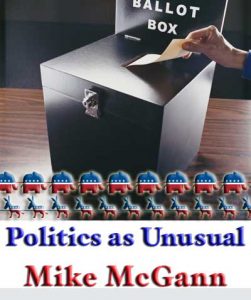By Mike McGann, Editor, The Times
 Republicans across the state of Pennsylvania are howling mad and running to the courts seeking assistance.
Republicans across the state of Pennsylvania are howling mad and running to the courts seeking assistance.
Karma is a bitch, right?
It seems like they may have to compete on a fair Congressional map — not the 2011 map that was among the most Gerrymandered maps in the entire country — and they don’t like it one bit.
Now keep in mind that the map the state Supreme Court imposed Monday still favors Republicans, just a little bit less egregiously than the old map. Best guess, Democrats are able to win eight of 18 Congressional seats in a neutral year — despite there being about a million more registered Democrats in the state. Currently, there are 13 Republicans and five Democrats.
So to be clear on the facts: the old map was rigged and deprived voters of their rights to fairly select representatives in Congress. And Republicans are really, really upset that has been changed. Karma, indeed.
Outside analysis of the new maps — including a detailed one on FiveThirtyEight.com — suggest this is a pretty fair map. For a number of reasons (not the least of which is the packing of Democrats in Philadelphia), it is difficult to create a map that is evenly balanced, so some lean toward Republican is inevitable.
In a normal year, Republicans can expect to win about 10 of 18 seats. Less in Democratic wave years — as 2018 looks to be — maybe as few as seven. But, in a GOP wave year, 13 seats would be in play for Republicans. So, again, despite the fact that there are million more registered Democrats and 2016 vote was about 50-50, the new map still gives Republicans an edge.
The map does massively change the southeast — building a couple of likely Democrat districts and a couple more, including the new 6th which takes up all of Chester County, that lean Democrat.
In turn, that could change money and turn out in coming elections — we could see better Democratic turnout because their voters feel like their candidates have much better chances to win, while in turn we could see less GOP turn out for the inverse reason. That could lead to changes in the makeup of the state legislature — and unless proposed legislation (see below) changes it, it could lead to Democratic Gerrymandering (which, by the way, I have an equal problem with — I don’t think politicians should get to choose their voters).
Aside from the anger about the outcome, Republicans argue the process was wrong — claiming the state is in midst of a Constitutional Crisis.
Maybe if legislative leaders didn’t have their heads up their butts, they might be right.
Had the legislature — the full legislature — created and voted on a map and the courts disregarded it, they might — might — have had an argument on a Article I, Section 4 argument on the U.S. Constitution. The problem is this: by merely submitting a map from Senate Pro Tempore Joe Scarnati and House Speaker Mike Turzai, rather a map that was voted on, the legislature failed to do its duty, leaving the courts little option but impose a new map.
That when Scarnati and Turzai submitted a map, it was just as Gerrymandered as the old map, didn’t help any.
The legislature’s failure to comply with court orders to supply data on the districts and precincts is another problem. The court wasn’t simply looking for data to draw up new maps (obviously, it had that covered), but rather to have data to see how the Scarnati/Turzai map was drawn and be able to make a more fully informed decision.
That, of course, didn’t stop a couple of federal officials from playing the “impeachment” card — U.S. Sen. Pat Toomey and U.S. Rep. Ryan Costello (R-6). Costello further alleged a dark conspiracy between Gov. Tom Wolf and the state Supreme Court — without, of course, providing any evidence.
If the state court failed in process — an open question considering how poorly the legislature reacted — one would assume that U.S. Supreme Court will intervene. If not — this impeachment talk is highly irresponsible, and makes Costello in part particular seem like a poor loser — someone actively arguing against fairness and fighting to restore an unfair map for his own benefit. It’s lousy political tradecraft and just kind of low rent.
Let us keep in mind that old maps were blatantly Gerrymandered. Should not the emphasis be on making sure voters’ rights are preserved over that of elected officials?
Should the state house move articles of impeachment — a simple majority would move the articles to the state Senate for trial — it would likely signal the career end for a number of, if not all, southeastern Pennsylvania State Representatives, a number of which are already on thin ice this year.
If it gets to the state Senate, then yes, the odds are good that five (as Max Baer was a no vote, I’m not sure how he got lumped into this, except for the fact that he happens to be a Democrat — making this whole thing seem even more transparently political), it would fall on Gov. Wolf to appoint new interim judges — who would have to be approved by the state Senate, likely triggering a standoff and leaving the state without a functioning state Supreme Court.
Again, I think these guys really fail to understand how this is going to play in the southeast — and how it could lead to devastating losses up and down the ticket, already facing headwinds nationally and at the top of the ticket, with Scott Wagner the likely GOP gubernatorial candidate and Lou Bartletta, the likely U.S. Senate candidate. Both will be a big drag on GOP turnout in the southeast. Neither is a candidate old school Republicans, used to the likes of Tom Ridge, John Heinz and Richard Thornburgh, will be comfortable voting for and could give many voters an excuse to stay home on election day.
That having been said, I think most folks would agree that the redistricting process we have now is not working. Bills have been posted in the state Senate and House to change the process and put it in the hands of non politicians. At this point, it seems to be bottled up in committee.
I asked local State Rep. Eric Roe (R-158), sponsor of the House version, on Facebook about his take on the new map and he was pretty forthcoming and less inclined to spew invective (despite his relative youth, he is acting like an adult), but instead noted that the structural problems relating to redistricting remain and need to be addressed:
“It’s certainly more compact, contiguous and competitive than the maps that have been used for the past seven years. No doubt about that. The process is the part I have trouble with,” Roe said.
“So long as it’s drawn by elected politicians, I’m not sure I’ll ever trust them to draw the maps without some sort of partisan consideration. (I’m not necessarily accusing the PA Supreme Court of using partisan criteria, I just don’t know with certainty how on earth they came up with such a consequential map in so little time.)”
He argues that now is the time to move forward with his bill to take redistricting out of the hands of politicians.
“That’s why now is the best time to enact SB22/HB722 to provide a 1) transparent, 2) equally bipartisan, and 3) thorough and deliberative citizen-led commission of non politicians that is full of checks and balances,” Roe said.
“In summary, this ruling didn’t change much,” he said. “It brought a four-year, short term remedy to a two centuries old problem. It addresses the symptom, not the disease. What I’ll be sharing at my next two town halls this spring is that we still have a system designed to gerrymander. The system has to change if we don’t want to keep having this fight between the legislature, the governor, and the courts every so often. Just think about how many taxpayer dollars have been spent over this multi-branch fight over the past couple of months!”
Kind of hard to argue with the logic, there.
***
The new districts are good news for someone not running for Congress: Chester County County Commissioner Kathi Cozzone. Cozzone is running for Lt. Governor and likely will get a boost from Madeline Dean’s decision to drop out of the Lt. Governor race to instead run for the newly created 4th District Congressional seat. Dean had been strong on fundraising and made those in the southeast seeking to support a woman for Lt. Governor face a tough choice between her and Cozzone. Now, Cozzone should pick up some of that support in a primary race that seems to be between her and John Fetterman, based on the limited polling out there.
***
The shooting last week in Florida has again sparked debate over whether school campuses should allow guns — specifically having armed teachers. Some of that debate flared locally a couple of years back when a parent left a gun in an unlocked, running car at a local middle school.
This sort of argument falls to the classic “the only way to stop a bad guy with a gun, is a good guy with a gun,” point made by gun rights’ advocates.
But do the facts line up with such an argument?
If you dig into the data involving shootings, and I focused on police shooting incidents, as they are both weapon and situationally trained far beyond what the typical civilian is, the numbers aren’t good. What they suggest is that firing accuracy is less than 30% in those situations — that is shots by the good guys hitting the bad guys.
But let’s dig into that scenario a bit more.
Let’s say you are a middle school teacher with a concealed carry Glock 19, a popular, lightweight, small and easy-handling semi-automatic handgun. An armed intruder, such as the one who attacked the school in Florida, is in the building with an AR-15 type weapon.
Okay, first off, you’ve got a bit of a weapons mismatch problem. Your Glock is going to fire a 9mm round at about 1,000 feet per second (FPS), while the bad guy is going to be firing a .223 round at around 3,000 FPS. He has a smaller bullet, but its higher velocity gives him longer range and greater stopping power. With a long barreled weapon, he is likely to have an accuracy advantage, as well. If you both hit each other once, your wound is more likely to be debilitating.
Additionally, you have a massive tactical problem. In your classroom, you have 25 to 30 kids. Hopefully, they’ve been drilled and are taking as much cover as a classroom offers, which is not a large amount typically.
You as a teacher, need to be careful with your shots, making sure to only fire at the perpetrator. The gunman has no such worry and can literally “spray and pray” and hope that shooting your students is a distraction that allows him to take you out. When you return fire, you have to make sure you not only hit the attacker, but not hit any stray students who happen to be in the area — scared kids move in unpredictable ways. I doubt any teacher could live with the idea of inadvertently killing a student.
Keep in mind, friendly fire happens in both military and police situations, by highly trained people — who make honest mistakes in the “fog of war.”
Another problem: you and a number of teachers are in the building armed. Law enforcement responds. How do they know you are the “good guy?” Hopefully, there is time to identify yourself and put down your gun — but things tend to move fast in these situations, especially with trained tactical officers on high alert to any armed gunman.
Given time and thought, the entire scenario tends to break down as so much wishful thinking.
Which while it may not excuse the decision of the armed resource deputy at the school in Parkland, Fla. choosing not to engage with the gunman, it may well explain what he was thinking in the moment. In fairness, unless you’ve been under fire — and haven’t, say, skipped the chance because of “bone spurs” — it’s hard to say what any of us would do in the moment. Some very special folks run to the danger, but that’s what makes them special, heroes in my book.
Asking teachers, special already in other ways, to do that seems not just a stretch, but a testosterone-driven fantasy.
And the weapons mismatch issue is a real thing. I’ve had a number of police officers privately tell me it’s one of their biggest concerns — they never know what they’re walking up against, and whether they are going to be outgunned.
So, there’s that.
And of course, how do we pay for it? Already schools across America are underfunded — we have schools using decades’ old textbooks in some districts.
When you have to do this sort of mental and logistical gymnastics to support keeping these military style weapons on the street, it is revealing.
Lastly, the attacks on these kids from Parkland are a disgrace. As the father of two not quite 17 year olds, I know them to be well-informed (better than I or my friends at the same age were in 1981) passionate and very much able to coordinate and share opinion. Expect the continued attacks on these kids by some on the right — who as a group love to delegitimize anyone or any group that criticizes them — to make this growing youth movement even more galvanized.
Let us hope that school districts here in Chester County do not attempt to penalize students for expressing their outrage during planned walkouts in March and April. Already, it appears some communities — Downingtown seems to be one — are formally declaring their support for the March 14 walkout. Students nationally plan to leave their schools for 17 minutes (one for each student killed in Parkland) at 10 a.m.
Peaceful protest, such as this, is what our country is built on.
Lastly, let me say I don’t think there is a school building in Chester County that is entirely safe from such an attack. That’s not to say that any local school administration or school board has not done its utmost to protect kids and staff — they have.
Unless we’re willing to make our schools into small maximum security prisons, there’s no way to make them entirely safe from attacks. There are too many human factors — doors left open by students accidentally, lapses in judgment, imperfect retrofits of decades’ old buildings when such attacks were unthinkable.
Do we really want to doom our kids to life in prison-like schools? Do we have to do the same things for malls, movie theaters, stadiums, offices — everywhere? At what point is life in a bunker acceptable?
How much of the right to life, liberty and the pursuit of happiness are we expected to surrender before we can finally have a real conversation about guns?







Well written and argued.